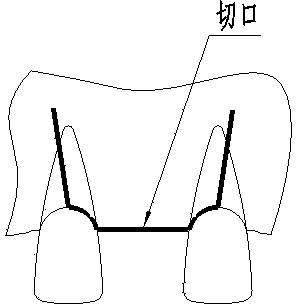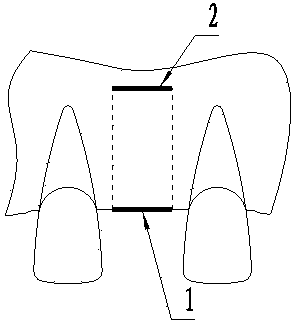Anterior tooth minimally invasive windowing oral implantation method
An implant technology and window opening technology, which is applied in the field of fenestration implantation technology of the labial and buccal mucosa of the upper and lower anterior teeth aesthetic areas in oral implantation, can solve the problems of affecting the aesthetic effect, gingival recession, gingival scars, etc., and achieves short operation time, Less swelling and less chance of infection after surgery
- Summary
- Abstract
- Description
- Claims
- Application Information
AI Technical Summary
Problems solved by technology
Method used
Image
Examples
Embodiment 1
[0025] Example 1, such as figure 2 As shown, it is a minimally invasive fenestration implantation technique in the anterior region. Its key point is that its fenestration approach is a transverse incision at the bottom of the vestibular groove on the labial side of the implantation area; the implantation approach is at the alveolar crest. The fenestration design is a transverse incision at the bottom of the vestibular groove on the labial side of the implant site.
[0026] Specifically, make a transverse incision along the alveolar ridge top at the implant site, or use a gingival ring cutter to remove the alveolar ridge gingiva, make a transverse incision A 1, and then make a transverse incision B at the bottom of the vestibular groove on the lip and buccal side of the implant area 2. Use a periosteal separator to subtly peel off the periosteum from the transverse incision A 1 to the transverse incision B 2, and make the incisions A and B run through. The thick solid line in...
Embodiment 2
[0035] Example 2: If there is a defect when observing and probing from the transverse incision A and transverse incision B during the implantation in step (3) of Example 1, if there is a defect, the attached gingiva of the adjacent teeth can be appropriately peeled off according to the specific situation, and can be directly observed Or check the condition of the buccal bone plate, first implant bone powder and cover the periosteum, fill the bone defect with artificial bone powder, and cover the collagen film; if the bone defect is large, the thickness of the remaining alveolar bone in the implanted area is ≤3 mm, and the height is ≤7 mm. Autologous bone grafting is required, followed by sutures and follow-up examinations. All the other undescribed parts are the same as in Example 1.
PUM
 Login to View More
Login to View More Abstract
Description
Claims
Application Information
 Login to View More
Login to View More - R&D
- Intellectual Property
- Life Sciences
- Materials
- Tech Scout
- Unparalleled Data Quality
- Higher Quality Content
- 60% Fewer Hallucinations
Browse by: Latest US Patents, China's latest patents, Technical Efficacy Thesaurus, Application Domain, Technology Topic, Popular Technical Reports.
© 2025 PatSnap. All rights reserved.Legal|Privacy policy|Modern Slavery Act Transparency Statement|Sitemap|About US| Contact US: help@patsnap.com


